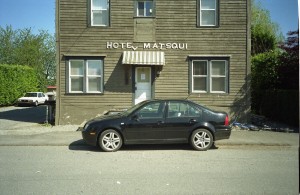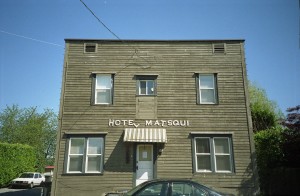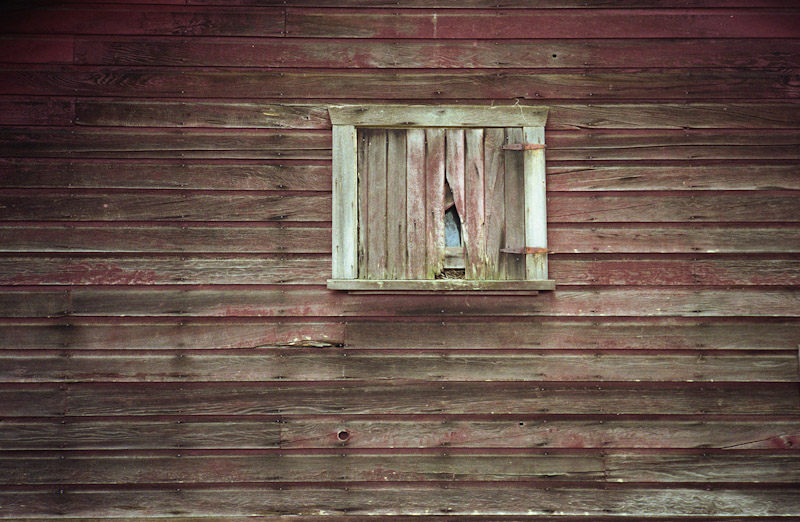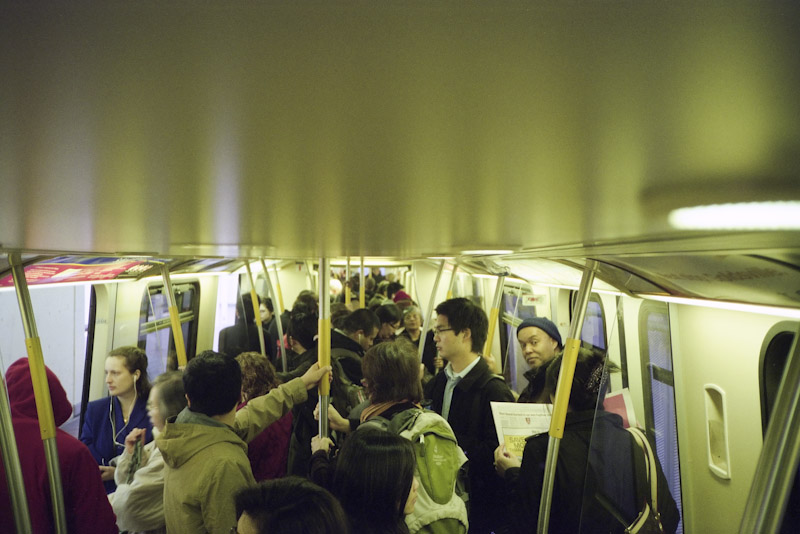May
18
2010

 The technique of joining two images together to create a larger view is mainly associated with digital photography but it can also be used with film that has been scanned into the computer. If the intention is to provide multiple viewpoints simultaneously as in a David Hockney photo collage then using stitching software isn’t necessary. If you want to create a seamless view however then you need some way to adjust perspective and join the images. Here I wasn’t able to get in all of the view so I just took two pictures with the intention of stitching them later.
The technique of joining two images together to create a larger view is mainly associated with digital photography but it can also be used with film that has been scanned into the computer. If the intention is to provide multiple viewpoints simultaneously as in a David Hockney photo collage then using stitching software isn’t necessary. If you want to create a seamless view however then you need some way to adjust perspective and join the images. Here I wasn’t able to get in all of the view so I just took two pictures with the intention of stitching them later.

Now I have an image that I was unable to capture within a single frame. I’ve used this technique in more extreme situations such as when I wanted to take a reference photo of a scene behind a construction fence. I blindly took images while holding the camera over the fence and then later pulled them all together into a single scene which will be the basis of a painting.
1 comment | tags: composition, film, Photography, stitching | posted in Composition, Photography, Processing, Uncategorized
May
13
2010

In the spirit of my relentless pursuit of testing irrelevant cameras. Here is the Canon WP-1 a water proof camera with it’s 32mm f3.5 lens. The lens has a lot of barrel distortion and doesn’t provide much contrast. What contrast you do see is the enhancement I have provided during scanning. While it has a dedicated macro mode the flash is forced on limiting it’s usefulness. So while it has a useful and somewhat unique focal length and a large viewfinder it is not a very good performer, and besides it’s gaudy.
no comments | tags: camera, Canon, film, Photography | posted in Cameras, Photography
May
6
2010



Where do you see rectangles, everywhere? If you can imagine the world in front of you as a flat two dimensional plane it can be an interesting exercise to look for ways to divide it. It can be helpful to look through the viewfinder to generate that flat view and frame a scene but with practice you can spot images without the camera. So why would you want to do this? Like any exercise in seeing it helps to broaden your visual acuity.
no comments | tags: camera, composition, design, film, olympus, Photography, xa2 | posted in Composition, Photography
Apr
26
2010
I find I really like the 35mm focal length that the Olympus XA2 has as well as many other small cameras from the late 70’s early 1980’s. It’s noticeably wide yet gives a convincingly natural field of view. With the Xa2’s three zones of focus you might think that it would be difficult to achieve sharp results but this isn’t the case and it also frees you to work on composition rather than focus. These images where processed in Lightroom.


1 comment | tags: camera, film, olympus, xa2 | posted in Photography
Apr
22
2010

When I first saw this forgotten water bottle I wasn’t to sure what to make of it but as I approached it became clear that this would produce an interesting subject against the ground of the artificial turf. The clarity achieved by this little camera never ceases to amaze me. The full size print I have of this (8″x12″) renders every blade of plastic grass clearly. The slight touch of contrasting colour and the harsh shadow created by the mid day sun all add to this image, making the water bottle stand in relief.
no comments | tags: composition, design, film, olympus, xa2 | posted in Composition, Photography
Apr
19
2010
It’s nice when things turn out like you planned even when your pushing the boundaries of your experience. I needed to take public transit to get downtown Vancouver so I ended up on what is called the “Skytrain” which was originally built for Expo 86. I brought along my Olympus XA2 because it fits in a pocket and I like the images it produces. During the commute I considered taking a few exposures inside the train but didn’t really see anything that was all that compelling. However as I was standing up the entire time I was near the ceiling and observed that the people where smeared into a diffuse reflection above. So I turned the camera upside down and pressed it against the ceiling. This did two things, it eliminated any camera shake and recorded the reflections. Really only one person paid any attention to me and even that was for only a brief moment.

2 comments | tags: camera, composition, film, olympus, xa2 | posted in Composition, Photography
Apr
15
2010

These images are of the Coghlan substation in North East Langley. It was part of the B.C.E Railway and provide power to the trains that traveled from New Westminster to Chilliwack south of the Fraser River. This section was completed around 1910 and carried it’s last passengers in September 1950.

no comments | tags: film, Photography, Processing, xa2 | posted in Photography
Apr
13
2010

Let me explain, from around 1957 to 1963 there was a Japanese camera company that manufactured under the name Beauty. There really is very little information available so I’m relying on Camarapedia for much of it. http://www.camerapedia.org/wiki/Beauty_Lightomatic. This particular camera the Lightomatic, “wasn’t everything in the fifties ‘omatic?”, has a fast f1.9 45mm lens. The selenium cell is attached to a meter visible on the top and is coupled to the shutter and aperture. A unique feature of the film advance lever is that it needs to be left partially out otherwise the shutter is locked. The viewfinder has parallax correction and shows a generous amount of area outside the picture frame. It’s an attractive camera that I will need to test further to determine it’s strengths and weaknesses.

1 comment | tags: beauty, camera, film, Lightomatic, Photography | posted in Cameras
Apr
9
2010
“I’m so young and you’re so old”-Paul Anka
No not that Diana, the made in Hong Kong plastic nearly everything camera of the early 1960’s. I spotted this camera in an antique store. It was absolutely the worst camera I have ever seen, so I bought it. It really can be distilled down to this, it is a semi light tight box with a single element plastic lens that produces an assortment of distortion and yields images with less contrast than Banff in a blizzard. So what is the appeal? Some people claim it allows the freedom to just create images. I claim it allows you to blame the camera when you don’t. Yes a distinctive look can be achieved with this camera but at what cost. For me I believe using it was a one time deal. I would rather use a Zeiss Ikon or a Voigtlander Bessa, if I want to shoot 120 on an old camera, I at least might have a chance of predicting the results and I’m sure I’ll still retain artistic freedom.

2 comments | tags: camera, Diana, film, Photography | posted in Cameras, Photography
Mar
31
2010

The automatic part of this camera no longer works so I thought I would find out why. It turns out that the selenium cell that is around the lens is no longer generating any voltage. It’s a very simple system where the voltage from the selenium cell deflects a needle connected to a small coil “galvanometer”. As the shutter is pressed there are two plates that move upward, on the top of these plates are steps that determine how far the plates slide based on where they intersect the needles horizo
Comments Off on Rondo Colormatic | tags: camera, film, Photography | posted in Cameras, Photography

 The technique of joining two images together to create a larger view is mainly associated with digital photography but it can also be used with film that has been scanned into the computer. If the intention is to provide multiple viewpoints simultaneously as in a David Hockney photo collage then using stitching software isn’t necessary. If you want to create a seamless view however then you need some way to adjust perspective and join the images. Here I wasn’t able to get in all of the view so I just took two pictures with the intention of stitching them later.
The technique of joining two images together to create a larger view is mainly associated with digital photography but it can also be used with film that has been scanned into the computer. If the intention is to provide multiple viewpoints simultaneously as in a David Hockney photo collage then using stitching software isn’t necessary. If you want to create a seamless view however then you need some way to adjust perspective and join the images. Here I wasn’t able to get in all of the view so I just took two pictures with the intention of stitching them later.




































